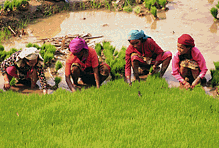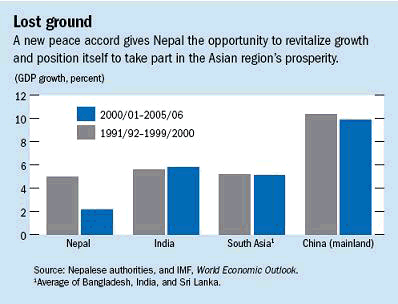
Typical street scene in Santa Ana, El Salvador. (Photo: iStock)
IMF Survey: Nepal Peace Accord Promises New Start
January 15, 2007
- Root causes of insurgency still need to be addressed
- Security-related spending can be reduced
- Higher growth will require raising productivity
On November 21, the seven-party alliance government of Nepal and the Communist Party of Nepal (Maoist) (CPN-M) signed a comprehensive peace accord.

Planting rice in Nepal (photo: John Heaton/SCUS).
ARMED INSURGENCY OFFICIALLY ENDS
It marked the official end of an 11-year armed insurgency and provided for arms management and an interim government and legislature in which the CPN-M would participate in the lead-up to constituent assembly elections in June 2007.
Over the course of the insurgency, there was a heavy loss of life. Nepal's real GDP growth also fell from the trend rate of 5 percent to 2 percent during 2000/01-2005/06, with political instability shaving off an estimated ¾ of 1 percentage point a year from growth (see chart).

The country, however, was able to maintain macroeconomic stability. Inflation remained in the single digits, anchored to price developments in India through an exchange rate peg to the Indian rupee. The fiscal position also stayed broadly satisfactory, with low overall and domestically financed fiscal deficits. The revenue-to-GDP ratio rose, but development spending was constrained by weak implementation capacity at the local level, especially in the conflict-affected areas. Remittances played an important role in offsetting low export growth and lower aid levels and allowed the country to maintain external balance. And, aided by strong remittances, solid wage growth, urbanization, and a decline in the dependency ratio, the poverty rate fell to 31 percent in 2003/04 from 42 percent in 1995/96.
Challenges ahead
The peace accord holds the promise of a new beginning for Nepal, but the root causes of the insurgency—low growth, pervasive poverty, and a perception that economic policies and institutional structures have not delivered adequate growth and equity—still need to be addressed.
Higher growth will require raising productivity across economic sectors. In agriculture, Nepal needs to vigorously implement its 20-year Agricultural Perspective Plan. This plan provides complementary inputs and rural finance for better irrigation, fertilizers, and farm machinery, and improved infrastructure to promote commercialization and market access for agricultural products.
In manufacturing, Nepal must boost competitiveness—through investments in infrastructure and an improved climate for doing business—and reduce transportation and transactions costs. It also has scope to exploit more fully Nepal's comparative advantage in sectors such as hydropower and tourism.
At the same time, Nepal will have to maintain sound macroeconomic policies. On the fiscal front, expenditure on social sectors and infrastructure will need to be stepped up, whereas security-related spending can be reduced. To keep deficits and public debt on a sustainable trajectory, Nepal will have to mobilize adequate external aid. Domestic revenue must also be increased through steps to broaden the tax base and improve taxpayer compliance and services. In all this, the public will demand greater fiscal transparency.
On the financial side, it will be essential to mobilize domestic resources effectively and improve intermediation to finance development activities. Enhanced legal and regulatory frameworks would underpin financial sector integrity, facilitate consolidation, and set the stage for Nepal to meet its World Trade Organization commitments to financial sector liberalization in 2010. In addition, the Nepal Rastra Bank must bolster its financial sector oversight. And the government will need to substantially increase loan recovery from large, willful defaulters and resolve nonperforming loans to improve the financial condition of the two largest commercial banks.
More broadly, Nepal must improve governance and service delivery to ensure that the benefits of higher growth are shared equitably. Strong efforts are required to better target programs for the poor, while reconstruction, rehabilitation, and relief help heal the scars of the conflict.
The IMF has been a part of the international community's efforts to support Nepal. Just ahead of the peace accord, the IMF Executive Board approved the second and third reviews of the Poverty Reduction and Growth Facility to support Nepal's Poverty Reduction Strategy and extended it for one year.







